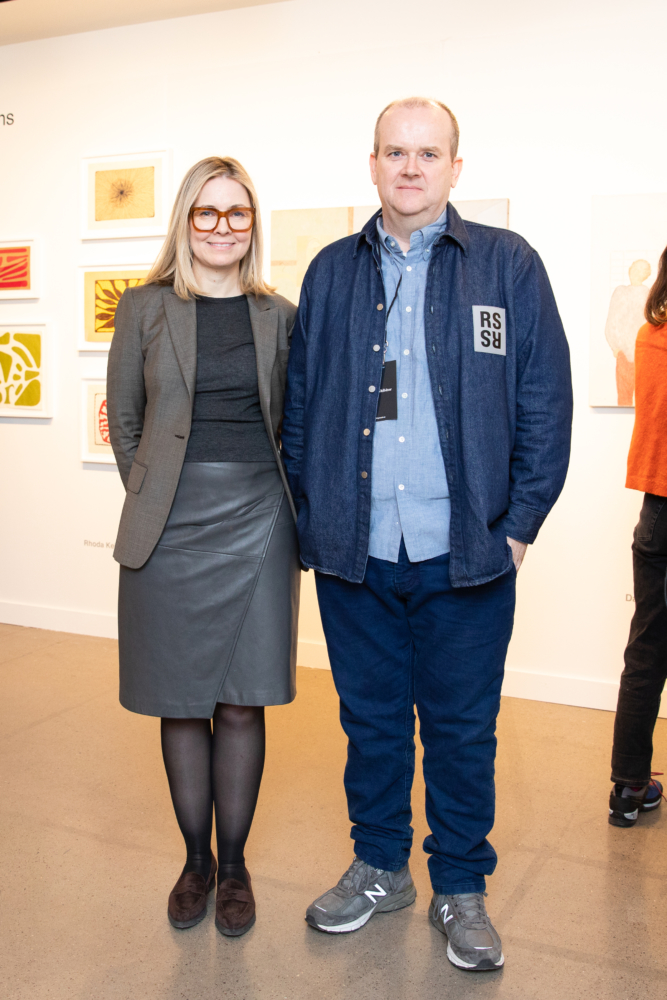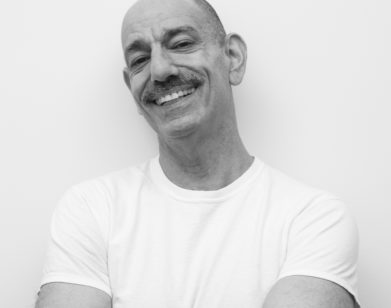Independent Art Fair Co-founders Elizabeth Dee and Matthew Higgs on a Decade of Measuring Success by a Different Name

Elizabeth Dee, Matthew Higgs.
The dust has just now settled from New York City’s yearly onslaught of art fairs. Triggered by the massive Armory Show at the beginning of March, it’s a frenzied moment for gallerists, curators, artists, and, most importantly, collectors. The sheer amount of art on offer can be overwhelming, even for veterans of art world programming, and exhausting. For those who find themselves curious about fair life, but unaware of exclusive blue-chip gallery gatherings or without the stamina to circumnavigate Pier 94 for the Armory, there was one fair that was continually suggested to us, via word of mouth, no less: the Independent Art Fair. For its 2019 exhibition, Independent tucked itself into TriBeCa’s reasonably-sized Spring Studios to present works from well-respected NYC galleries Karma, Anton Kern, White Columns, Canada, and Marlborough Contemporary — in addition to dozens of international exhibitors such as London’s The Sunday Painter and Oslo’s Standard galleries. The blend of outsider works with emerging international artists is nothing short of a choreographic act carried out by the fair’s long-time curators Elizabeth Dee and Matthew Higgs. (Higgs also directs programming at White Columns). Their curatorial work, which is a year-round process, has lead to the emergence of Independent as a glorious glitch in the art world machine. It exists on a small scale. It breathes. It’s not cravenly assembled to leach into your social media feeds — in this sense, it’s nearly utopian. And for artists, as the critic Roberta Smith has pointed out, inclusion to the Independent is bit like “anointment.” It is, to say the word that means both everything and nothing in 2019, an experience that everyone wants to participate in. Naturally, Interview just had to speak with the minds behind Independent to discuss how much the art world has evolved (or mutated), the age of the art fair, and that surprising moment when a year’s worth of work finally materializes on the floor.
—–—
NATHAN TAYLOR PEMBERTON: What are some of the biggest changes you’ve recognized in the art world after ten years of putting on Independent?
MATTHEW HIGGS: Something everyone who’s interested in or involved with art has to negotiate is the rise of art fairs, and the way that art fairs have changed the nature of the art world. That’s really been the dominant story in the past decade. That was exactly why Independent began. We hoped that it was possible to create a more interesting and different platform within that reality. Ten years later, of course, the dominance of art fairs is now being discussed in a somewhat negative way, I think.
PEMBERTON: Is it really?
HIGGS: I think so, when it comes to the larger fairs, because of their scale. There’s this pushback now. I don’t have the numbers in front of me, but I think a significant part of a gallery’s income is now dependent on sales they make at art fairs. This wasn’t exactly the case a decade ago. Now, there’s something like 300 art fairs each year. There is essentially an art fair for every day of the year! If there are going to be art fairs, and if art fairs are to remain an integral part of the art world economy, then the question remains for Independent: How do we create a significant experience for everyone, and how do we make it work financially? Can you do that in the current circumstance? I think Elizabeth and her team, they managed to do that.
ELIZABETH DEE: We had a sense this was coming ten years ago. The resistance was already happening, and being people who would rather find a solution than discuss the problem, we decided to incubate this idea without a huge agenda. Honestly, I don’t think Matthew and I thought this would be a repeat performance, but because of this conversation’s momentum, it’s now reached a demand that we would not have imagined when we started. What we’ve always tried to do at Independent is to bring in as many different voices as possible, and include voices that typically we haven’t seen in the larger art fairs. We’ve always tried to place the emphasis on the relationship between art and the experience, with less concern about the economy — even though we know and understand it was an essential part of the mix.
PEMBERTON: What were some of the specific features at this year’s fair that you were most excited about?
DEE: What I love about this project is that it has a memory in people’s minds that continues to evolve. I mean this in the sense of past editions, but also in how recent art encounters develop a perspective over time. Being on site for a full week with the presentations changed my point of view and that is really inspiring. I definitely continue to think about Gertrude Abercrombie’s work at Karma gallery. Even though I had seen some of it before Independent, I just feel that having the chance to spend so much time with that material has been really special. I also think that Julie Curtis at Anton Kern in connection with the Marepe sculptures was an unexpected intergenerational presentation that I loved seeing together. It was somewhat playful and yet, at the same time, very, very sharp.
MATTHEW HIGGS: One of the things that we really tried to emphasize is that this fair can be intergenerational, where contemporary galleries can bring historical projects by artists, but they feel very present. It doesn’t feel like it’s a historical, anachronistic narrative. It somehow feels very pertinent to what we’re looking and what we’re thinking about now. A really great example of that is a gallery that was exhibiting at Independent for the first time, Rossi and Rossi. They were presenting the work of Siah Armajani, a very significant artist who came to prominence in the 70s and 80s, and whose practice has been hugely influential on a younger generation of artists. I think Independent allows for us to look at these historical bodies of work through a new, more contemporary, present-tense lens.
PEMBERTON: How have you responded to the rise of social media and how art fairs seems to be measured and graded on how much they can be Insta-candy for attendees?
DEE: It’s been interesting to see more the shift of all media change with the impact of digital and social media. Certainly, I think more and more people in the art world are looking to their peers. Matthew’s very involved on social media. I follow everything that Matthew is doing.
HIGGS: Cumulatively, the reach of Independent is far greater than its scale. Obviously, doing anything in New York City now is very expensive and logistically complicated. That fact has been, and remains, the greatest struggle, not just for Independent, but for small scale and mid-sized galleries. How do you continue to function in a city that is increasingly prohibitively expensive? I think in the last ten years, we’ve found our perfect scale for the fair. Personally, I wouldn’t want to see it getting any bigger because I think you’d lose the intimacy of the experience for the visitor.
DEE: Absolutely. Part of it is that galleries now are communicating this direct experience through these social media channels. The artists and the galleries are the experts on the material. In a way, if we can bring their communications around their presentations, together for that week, and be able to bring that forward as a collective platform, I think that’s a really strong positive evolution of how things have moved. We certainly didn’t have that happening ten years ago.
HIGGS: The main point of Independent is to create a very focused, in-person encounter for everyone. Obviously, social media is one way to create a larger awareness of that, but the real purpose of the fair is to create a real-time physical experience for artists, gallerists, and visitors alike. Where, hopefully, the reality of the actual experience is meaningful.
PEMBERTON: How do you measure “success” in this context? Is it a sales thing? Is it attendance? Is it the number of times a hashtag was shared?
HIGGS: I think at the absolute end of the day, if artists — living artists — are involved, and they’re happy with the experience, that’s mission accomplished. The most important thing is that it adds something to everything else that’s on offer in New York City — that we create a distinct, idiosyncratic experience for visitors. We’re aware that there’s too much to do in New York City at any given time. We’re aware that there’s plenty of opportunities to go and see art. Independent needs to be different and distinct, in order for us to justify everything that goes into making it happen.
DEE: If I have to bring all that down into one word, it’s quality — and being able to add to the conversation with a platform, now year round, that is special and unique in contrast to what can be possible in other contexts.
PEMBERTON: What is that feeling like, seeing all of that after it manifests itself in a private moment for both of you, when the show has been set up?
DEE: It’s a freedom, a certain kind of liberation. I think so much of my role in supporting the project has been the management of affording that opportunity to happen. Then when I get beyond the production phase, it becomes a moment where everything coexists and creates its own narrative. It’s a very special thing. It makes the work worth it.
HIGGS: For me at least, it’s about entering one space and then exiting into the next space — and having an opportunity to think about the two different things that I’ve just seen. Then as you enter third space and so on, that idea of an accumulative experience with knowledge and information, and then how you process that experience on a very subjective and individual basis, for me that is always the most exciting thing. Just walking through a space and drawing connections between things, and starting to think about things that you perhaps hadn’t had an opportunity to think about before together. I’d be very surprised if any one person liked everything they saw at Independent. But we hope that the visitor at Independent will put together their own compelling narrative from what they encounter. I think that takeaway from the fair is important — the residue and the legacy of one’s own experience.
PEMBERTON: How long do until you begin to plot the next fair?
HIGGS: I guess it starts in a week or two. It never stops.






